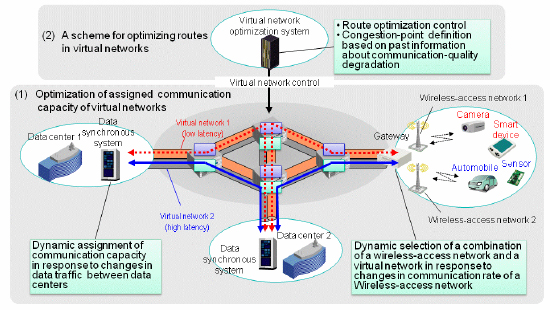Information contained in this news release is current as of the date of the press announcement, but may be subject to change without prior notice.
March 10, 2011
Hitachi, Ltd.
Keio University
Tokyo, March 10, 2011 – Hitachi, Ltd. (NYSE: HIT/TSE: 6501, “Hitachi”) and Keio University today announced the development of communication control technology to improve the efficiency of network utilization by using multiple virtual networks based on the communication speed and capacity requested by the application, as part of efforts to realize the New Generation Network*1 for 2015 and beyond. This technology will enable telecommunications carriers to provide high-speed communication to a larger number of users, as well as allow users to use various types of applications at a low cost.
This result is a part of the research project “Development of platform technologies for data service applications based on virtualized networks” supported by the National Institute of Information and Communications Technology (NICT), Japan.
In recent years, there is a continuing demand for advancements in communication speed and capacity, fueled by the sudden increase in network applications due to the growing penetration of cloud computing and smartphone use. In the future, the need for reliable network platforms providing 24-hours 365-days services will increase further with the proliferation of systems based on sensor networks*2 such as disaster prevention and traffic control.
As such, R&D is currently being conducted on a new concept network (New Generation Network, or Future Internet), led by Japan, U.S., and EU. In particular, network virtualization technology which allows multiple virtual networks of different speeds and capacities to coexist in a single physical network and simplifies the extension of networks in response to new applications, is receiving attention, and joint industry-government–academia R&D is being promoted for its realization.
The communication control technology developed has two key features: (1) the optimal allocation of virtual network capacity based on communication traffic, and (2) the optimization of virtual network routes. Verification tests using a network simulator confirmed that compared to conventional methods used with the Internet, employing the virtual network route optimization technology approximately doubled the efficiency of the entire network. Details of the technology are described below.
Technology was developed to dynamically allocate capacity to virtual networks during fluctuations in communication traffic between data centers, such as during data back-up, based on calculations of optimal capacity to satisfy the requested communication speed of applications. In order to provide a comfortable communication environment to as many users as possible in the wireless environment, which has large fluctuations in speed, technology was developed to dynamically select in response to changing wireless network speed, a combination of wireless access and virtual networks capable of fulfilling the user request.
Technology was developed which optimizes the route for virtual network by considering the free network capacity from among the tens of billions of communication path combinations available. When compared with conventional techniques such as that used with the Internet, the technology developed doubled the efficiency of the entire network. In addition, a technology to identify the congestion points inside the network based on communication quality degradation history, was developed.
The result of this research will be evaluated on in pilot test platform for network virtualization technology. These results will be presented at the IEICE General Conference to be held from 14th to 17th March 2011 at the Tokyo City University, Japan

Hitachi, Ltd., (NYSE: HIT / TSE: 6501), headquartered in Tokyo, Japan, is a leading global electronics company with approximately 360,000 employees worldwide. Fiscal 2009 (ended March 31, 2010) consolidated revenues totaled 8,968 billion yen ($96.4 billion). Hitachi will focus more than ever on the Social Innovation Business, which includes information and telecommunication systems, power systems, environmental, industrial and transportation systems, and social and urban systems, as well as the sophisticated materials and key devices that support them. For more information on Hitachi, please visit the company's website at http://www.hitachi.com.